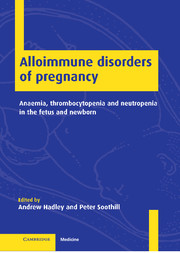 Alloimmune Disorders of Pregnancy
Alloimmune Disorders of Pregnancy Published online by Cambridge University Press: 26 October 2009
Introduction
Intrauterine blood transfusion of anaemic fetuses represents one of the great successes of fetal therapy. The therapeutic success of other potential therapies for HDFN, such as plasmapheresis, intravenous immune globulin, immunoabsorption, oral tolerance and chemotherapeutic agents, has been met with more mixed views.
Plasmapheresis and intravenous immune globulin
Plasmapheresis
An interest in plasmapheresis for the in utero treatment of HDFN preceded the improved perinatal survival realized in the late 1980s with modern intrauterine transfusion techniques. Most of the literature has reported single cases or relatively small case series (Table 10.1). Many of the studies used the historical control of the outcome of the patient's previous affected pregnancy to assess a therapeutic effect. In addition, plasmapheresis has often been combined with intrauterine transfusion or intravenous immune globulin (IVIG) making assessment of its effect more difficult. Despite these limitations, a review of the published cases reveals a perinatal survival of 69%. This would appear to warrant further scientific investigation into the use of plasmapheresis as an adjunct in the management of the severely alloimmunized patient. A randomized clinical trial was attempted by the Canadian Apheresis Study Group, but, unfortunately, insufficient enrolment necessitated premature termination of the study.
Reported protocols vary considerably but all involve repeated procedures due to a rebound increase in antibody titre. In animal studies, Bystryn and coworkers experimentally lowered antibody levels by exchange transfusion. Antibody levels were noted to rebound to over 200% of the initial levels with increases of up to 50–80% being seen even in the first 48 hours.
To save this book to your Kindle, first ensure no-reply@cambridge.org is added to your Approved Personal Document E-mail List under your Personal Document Settings on the Manage Your Content and Devices page of your Amazon account. Then enter the ‘name’ part of your Kindle email address below. Find out more about saving to your Kindle.
Note you can select to save to either the @free.kindle.com or @kindle.com variations. ‘@free.kindle.com’ emails are free but can only be saved to your device when it is connected to wi-fi. ‘@kindle.com’ emails can be delivered even when you are not connected to wi-fi, but note that service fees apply.
Find out more about the Kindle Personal Document Service.
To save content items to your account, please confirm that you agree to abide by our usage policies. If this is the first time you use this feature, you will be asked to authorise Cambridge Core to connect with your account. Find out more about saving content to Dropbox.
To save content items to your account, please confirm that you agree to abide by our usage policies. If this is the first time you use this feature, you will be asked to authorise Cambridge Core to connect with your account. Find out more about saving content to Google Drive.